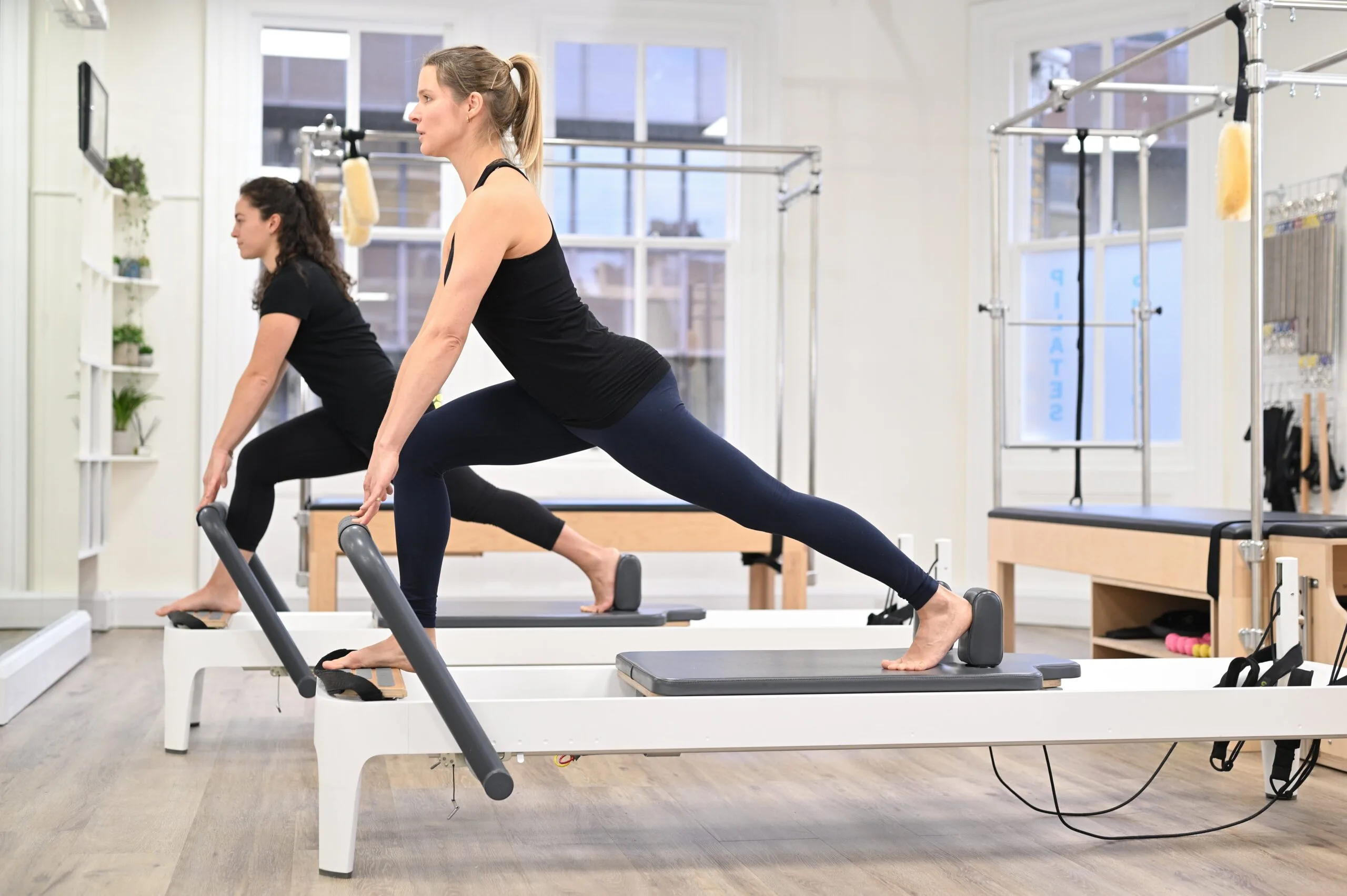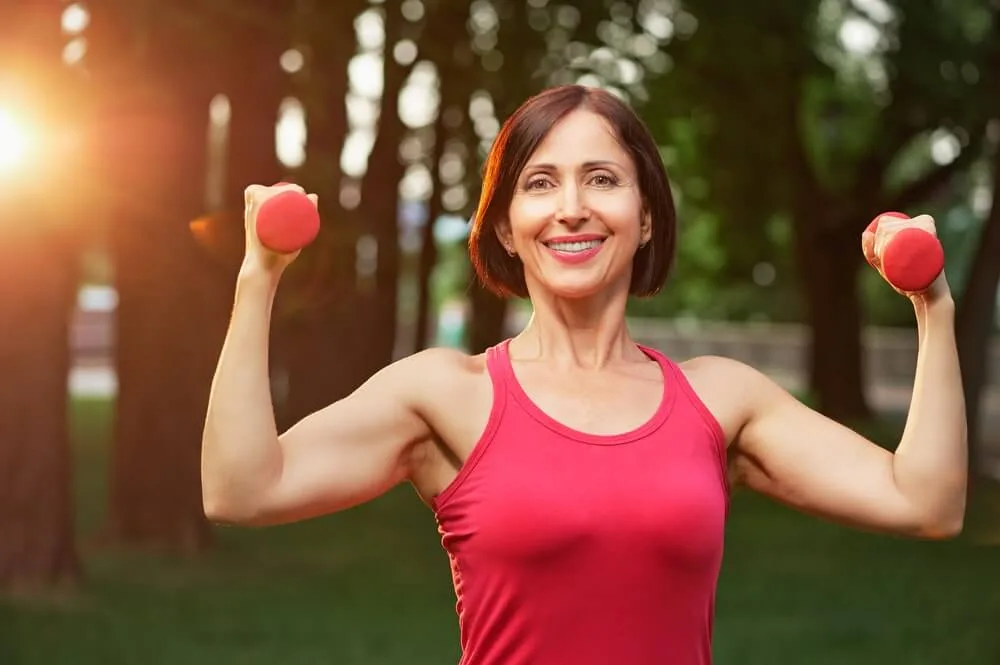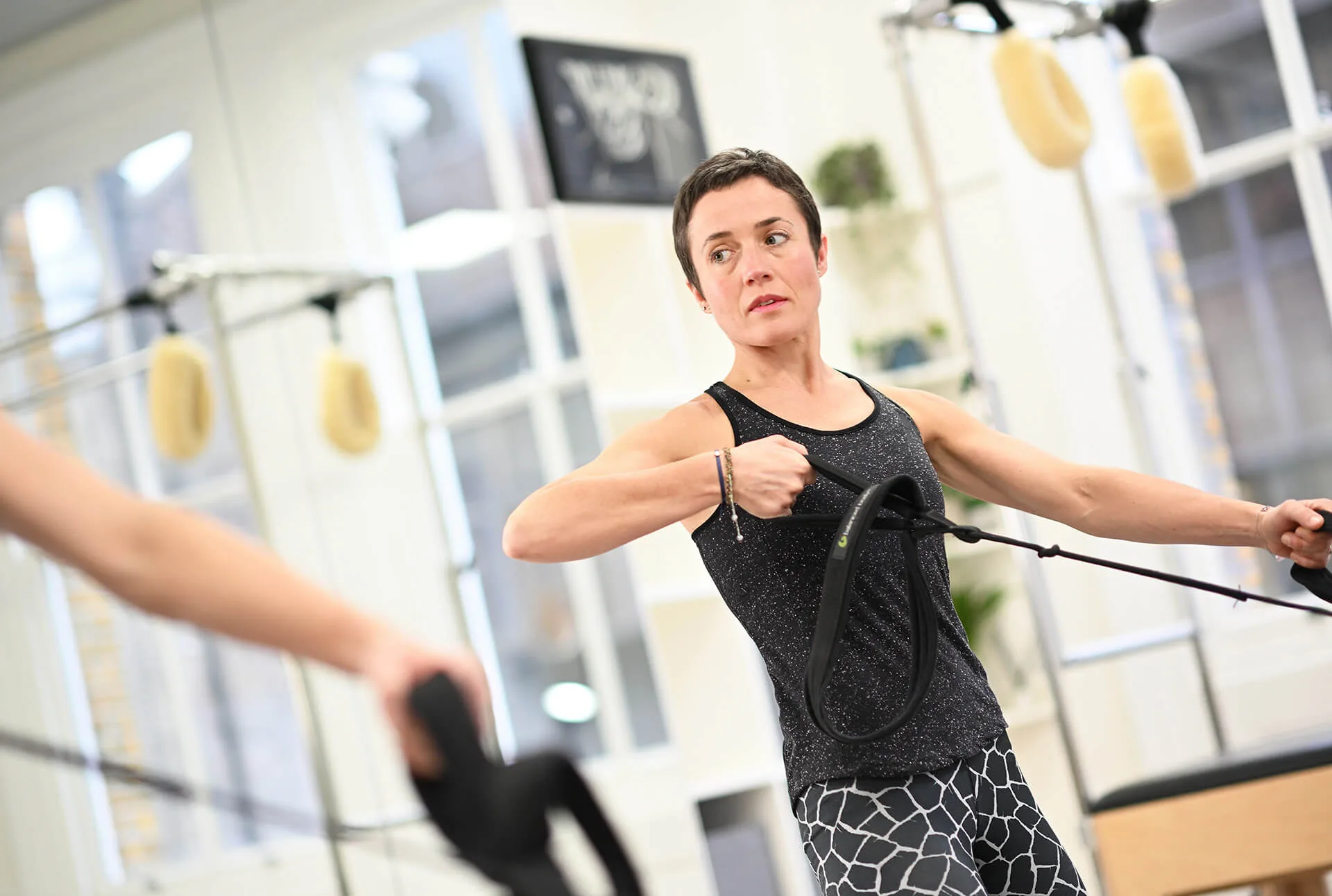Key Contributor: Susie Martin, Chartered Physiotherapist
Introduction
Over the last 30 years, we have seen somewhat of a revolution in the Pilates scene in the UK. Back in the day, Pilates was more well known as a type of exercise class which took place on mats on the floor. Only those in the know were aware of the large machines that were used for working on the full Pilates repertoire.
Nowadays, the reformer is much more widely known, and for some is now synonymous with Pilates. In the last decade, there has been an explosion of studios offering reformer Pilates. These range from large group classes designed for a really challenging workout, to smaller group classes with more emphasis on technique and even boutique, highly bespoke, individualised classes.
With all this on offer, it might be quite challenging to know which type of Pilates is right for you? Which, you might ask yourself, is better? Reformer Pilates or mat Pilates? To find out, read on…
Three key takeaway points
- Reformer Pilates and mat Pilates were both created at the same time, and both form part of a wider system of exercises, developed by Joe Pilates
- Both Reformer and mat Pilates are a great way to work on strength and mobility throughout the whole body. Both can provide a real challenge provided they are done with good technique, however reformer Pilates may have the edge on challenging workouts! Both are very versatile and can be adapted to make them suitable for anyone, whether they are beginners, returning to exercise after injury, or dealing with a chronic health condition.
- Whether you choose reformer or mat Pilates is largely a choice of preference as well as practical considerations, such as accessibility and budget.
What is mat Pilates?
Mat Pilates is essentially a type of low intensity strength training, combined with spine and joint mobility exercises. It is well known for the exercises that can challenge abdominal strength, but there are exercises in many different positions, targeting many different muscle groups.

Mat Pilates can be adapted to suit many people, with exercises ranging from gentle to challenging. As long as you are able to get on and off the floor, then you can benefit from mat Pilates.
Mat Pilates is just one part of the Pilates system of movement. The Pilates system is named for its founder, Joseph Pilates, who developed his own repertoire of exercises through self-study and his own experience of trying to improve his physical health.
He developed his technique – which he originally called contrology – to help rehabilitate prisoners of war. Mat Pilates was something that could be carried out using minimal equipment and taking up very little space.
Pilates’ exercises were based on the principles of breath, concentration, center, control, precision, and flow and these principles still form the basis of what we know as Pilates today.

One of the benefits of mat Pilates is its accessibility. Mat Pilates is very popular and has been around for quite a while now so you don’t have to look hard to find a local class or teacher.
Mat Pilates requires very little equipment, and doesn’t need to take place in a specialised setting, so you could be doing mat Pilates in a studio, a leisure centre, a church hall or even in your own home.
Whilst no large equipment is required, you may find that some mat classes also incorporate small pieces of Pilates equipment, to enhance your exercise experience further.

The low requirement for equipment or space means this is also the less expensive option, which will be an important factor for many.
What is reformer Pilates?

Reformer Pilates is part of the Pilates repertoire that takes place using a piece of specialised equipment – called – you’ve guessed it…….the reformer!
Whilst you may have heard of the reformer, you might not be aware that there are other other pieces of Pilates equipment, such as the Trapeze Table and the Wunda Chair. However, the reformer is probably the most popular due to its versatility and smooth action.
The Pilates reformer consists of a sliding platform, called a carriage, set within a metal frame. The carriage is attached to the frame by metal springs, which can act to provide resistance or assistance to movements. The carriage is also attached to pulleys and straps which can be used for various exercises.

Joseph Pilates originally designed the reformer, so although it has been updated and there are many, many different brands on the market today, the original reformer design is nearly as old as the Pilates method itself.
The reformer is an ingenious piece of equipment that can be used to add resistance to a mat style exercise, making it more challenging for strength. The moving carriage can also be used to challenge stability as it provides an unstable surface.
For example, a simple plank exercise can be made more dynamic using the reformer. By pressing the carriage back, your arms move away from your centre, creating a much longer lever and making it more challenging for your abdominals and back muscles.

However, the reformer doesn’t only provide a more challenging exercise repertoire – it can also be used as a supportive piece of equipment to make exercises easier!
For example, the feet-in-straps series (see the picture below) can be considered as a more supported way to work on abdominal strength. The straps support the weight of the legs, which is less challenging than trying to do the same exercise on the mat, unsupported.

The supportive nature of the reformer makes it really suitable for rehabilitation. However, it is important to work with someone who is trained in rehabilitation if this is your main aim. There is a world of difference between attending a reformer class designed for high level fitness and attending one that is designed for rehabilitation.
If you have never tried reformer Pilates before, then it is a good idea to seek out some 1:1 sessions with a well qualified Pilates instructor. They can show you the best technique for the basic exercises, so that you can get more out of any group classes you may choose to do.
Key Differences between reformer Pilates and mat Pilates?
| Feature | Reformer Pilates | Mat Pilates |
|---|---|---|
| Equipment | A Pilates reformer | An 8 – 10mm thick Pilates mat |
| Resistance | Reformer springs and cables | Body weight, small additional weights, resistance bands |
| Intensity | Low to high | Low to medium |
| Focus | Adding more interest, challenge and novelty to exercises. | Getting the basics right. |
| Best for | Those who have difficulty getting down on a mat, those who need more supportive exercise than the mat. Those who have been doing mat and want more challenge and want to work against heavier resistance. Those who want a dynamic, fun and varied workout. | Those who can’t access a reformer studio. Those for whom reformer Pilates is out of budget. Those who enjoy the feeling of being more grounded and in contact with the floor. |
Which one is right for you?
Both mat and reformer Pilates have fabulous benefits for most people but some people may have a clear preference for one over another.
Choose mat Pilates if you:
- Want to get to grips with basic Pilates techniques without interference from the equipment.
- Want to learn exercises that you can do anytime and anywhere.
- Prefer the added stability and groundedness that working on the floor gives you.
- Have a limited budget.
- Are unable to access a reformer.
- Have been working with a reformer for a while and want to explore a different part of the Pilates repertoire.
Choose reformer Pilates if you:
- Have back pain and struggle with some of the mat based exercises such as single and double table top leg lifts.
- Have difficulty getting on and off the floor – and need to exercise on a higher surface.
- Have been doing mat Pilates for a while and feel you have plateaued or you need to add some novelty to your routine.
- Want a really fun work out with the potential to add more resistance and more challenge through dynamic movement, stability challenges and complex choreography that challenges your co-ordination.
Can you do both mat and reformer Pilates?
You can absolutely do both mat and reformer Pilates! Both of the exercise formats complement each other and were originally designed to work together. Doing mat exercises helps you to understand the reformer exercises in more depth and vice versa.
In addition you may find some exercises are more challenging on the mat, whereas others are more challenging on the reformer. Reformer Pilates may look like the more challenging of the two, but in actual fact, the reformer machine can give you more support and more feedback about where your body is in space. When we take this away, as we do on the mat, you may have to work harder to control your movement.
Conclusion
Both mat and reformer Pilates have unique benefits, which nearly everyone can experience. Which one is best for you depends on a combination of factors, including your budget, location and personal preference.
When choosing either mat or reformer Pilates, if you are completely new to Pilates, we would recommend working on a one-to-one basis with an instructor so that you can become familiar with the exercises and equipment but also really understand and refine your technique when moving. This will ensure you get the best out of your Pilates experience.
FAQs about reformer Pilates vs mat Pilates
Is Reformer Pilates harder than mat Pilates?
You might be forgiven for thinking that reformer Pilates is more challenging than mat Pilates, since the reformer can resemble an piece of gym equipment.
However, the answer is not straightforward!
Reformer Pilates can definitely be more challenging than mat Pilates, since it enables you to add more resistance, challenge balance and stability and use more complex movement patterns that challenge your brainpower and coordination.
However, the reformer doesn’t make everything harder. In a lot of cases, the reformer can add more assistance to movements, which makes them easier!
In addition, being able to press feet or hands against a footbar or straps gives more tactile feedback and stability than exercises where your hands and feet are floating untethered in the air. Many people find this much easier to work with, and feels like a more natural way of moving – interacting with our environment.
Can I start with reformer Pilates if I have never done Pilates before?
Whilst many people start with mat Pilates, due to the fact that it is widely available and accessible, there is absolutely no requirement to start with only mat Pilates. Both types of Pilates can really complement each other.
In some ways, reformer Pilates may be easier to start with, since you receive instant feedback from the movement of the equipment when you are exercising. However, you may find the additional apparatus more confusing. This can disconnect you from your body and therefore you may prefer the mat.
The best way to know is to try both! Attending a Pilates studio, which contains all the large Pilates equipment, rather than a reformer only class setting, means that you get the opportunity to try exercises on different pieces of equipment, including the mat.
Which type of Pilates is better for injury rehabilitation?
It’s difficult to say which type of Pilates is better for injury rehabilitation, but they are both brilliant tools! The most important thing when undergoing rehabilitation is to work with someone who is a trained rehabilitation professional as they will best understand how to adapt the Pilates exercises and equipment for you.
Read on to explore how mat and reformer Pilates can work for rehabilitation using some more specific examples.
Back pain
For those who might be experiencing pain from a back injury – both reformer and mat Pilates can be really beneficial. Exercises which you can do lying down can often feel really relieving for back pain, since you are not loading the spine with body weight.
Reformer Pilates may slightly have the edge here, since the footbar, carriage and straps give an infinite variety of exercises that you can do in a very supported position. Anecdotally we find those with back pain find the reformer really helps them to exercise whilst simultaneously getting relief from back pain.
Hip or knee injury
If you have injured your hip or knee, or perhaps have had to undergo surgery, both mat and reformer Pilates will help you to keep the rest of your body mobile and strong, whilst you are recovering from injury.
However, the reformer provides more exercises to get you moving at the hip and knee. The reformer can help you with hip and knee range of motion exercises, in a position of non weight bearing. This makes it really safe, and often helps to relieve pain and discomfort.
Increasing the resistance with these exercises can also help you with strengthening.
Feeling inspired?
If you want to experience the Complete difference and discover the benefits of one-to-one Pilates, book a session at one of our London studios or online today.
Our physiotherapist-led Pilates studios in Chelsea, our Angel Pilates studio and our Pilates studio in City, offer a highly tailored approach to your Pilates training, whether your goal is to manage a health condition, rehabilitate from an injury or to improve your strength and fitness.
Get in touch with us via email or contact us on 0203 764 5668 for further information.
Education is key:
These blogs are designed to give information to everyone, however, it is important to remember that everyone is different! If you have not seen one of our therapists and have any questions about injuries, what you have read or whether this may be useful to you, please just ask. We are more than happy to help anyone and point you in the right direction. Our biggest belief is that education is key. The more you understand about your injury, illness and movement, the more you are likely to improve.





